A customer site I was at recently needed their XenDesktop 4 farm documented. Since I had already created PowerShell scripts to document the various versions of XenApp, I figured a XenDesktop script should be easy to create. This article and the script were written for “SR” at the customer site.
This article will focus only on XenDesktop 4. I am planning on writing articles and scripts for XenDesktop 5.x.
The prerequisites to follow along with this article are:
- A computer, physical or virtual, running Microsoft Windows Server 2003, Server 2008, Server 2008 R2, or Microsoft Windows XP, Vista, or 7 for running the XenDesktop Desktop Delivery Controller SDK.
- Citrix XenDesktop 4 Desktop Delivery Controller (DDC) installed with at least one Desktop Group created.
In this article, we will be installing the Citrix Delivery Controller SDK. You can install the SDK from either the XenDesktop 4 installation media or download it from citrix.com. Since I am at a customer site creating this script on a production network, I do not have access to the installation media. Therefore, I will be downloading the SDK.
My initial goal was to see if I could walk down the nodes in the Delivery Services Console (DSC) (Figure 1) and see if I could document every nook and cranny.
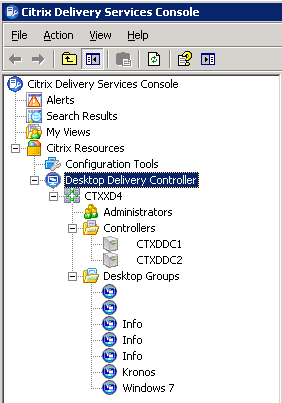
Note: For instructions on how to install the SDK from the XenDesktop 4 installation media, please see http://blogs.citrix.com/2010/08/11/xendesktop-4-powershell-sdk-primer-part-1-getting-started/.
Update 7-July-2021: Citrix, obviously, killed these old XD4 links.
For the SDK install, go to https://carlwebster.sharefile.com/d-s6239e1f90eb043d7a2642fbc61db997a
For the SDK Welcome, go to https://carlwebster.sharefile.com/d-s559804f9b3244ff58669263ab1e7dc06
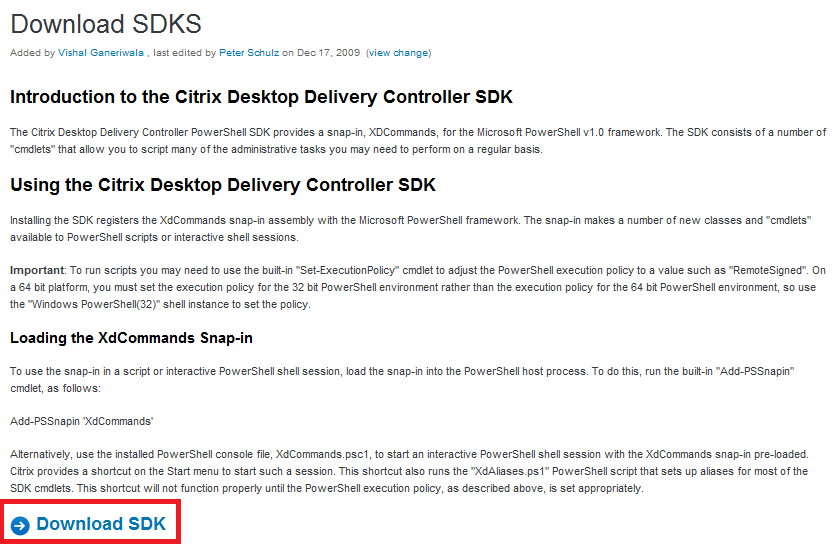
Click Start, Run, type in C:\XD4SDK\XenDesktopControllerSDK.msi and press Enter.
Click Run (Figure 3).
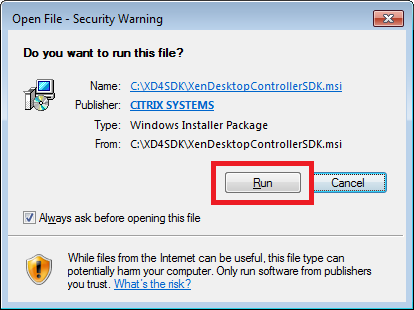
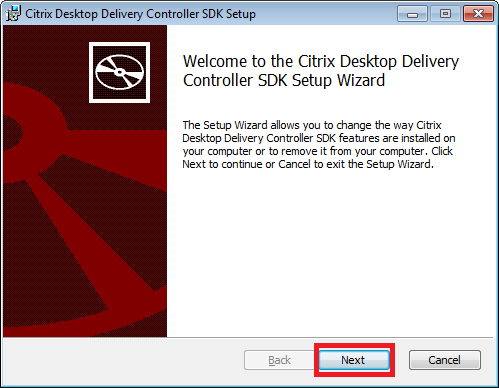
Select I accept the terms in the License Agreement and click Next (Figure 5).
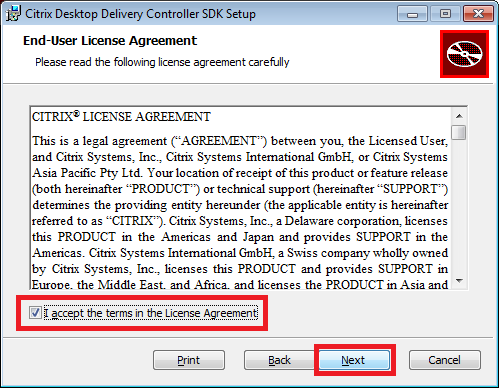
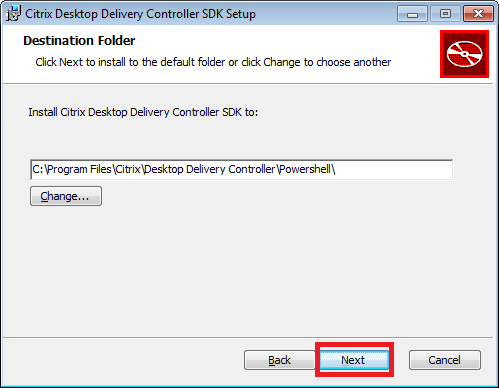
Click Install (Figure 7).
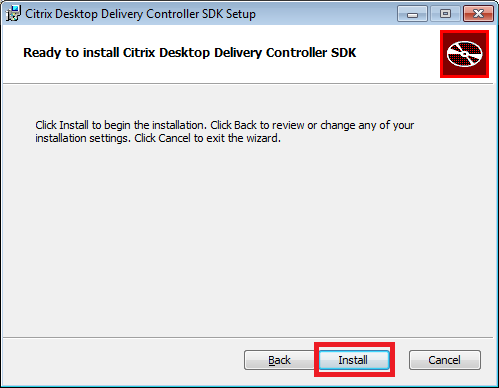
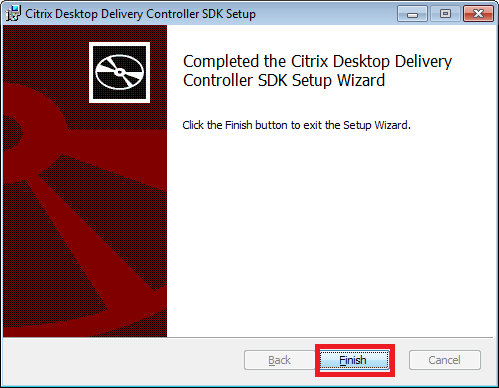
You now have new Start Menu items under All Programs, Citrix. Windows 7 is shown in Figure 9.
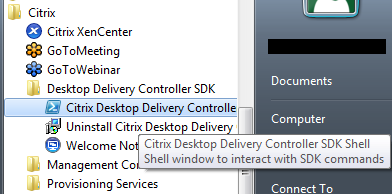
Everything is now set up for us to get started. The download page for the SDK says to get a listing of the available XenDesktop commands to enter the following command:
Get-Command -psSnapin XdCommands
Typing that line into the PowerShell session returns a list of Citrix XenDesktop PowerShell commands. A sample is shown in Figure 10.
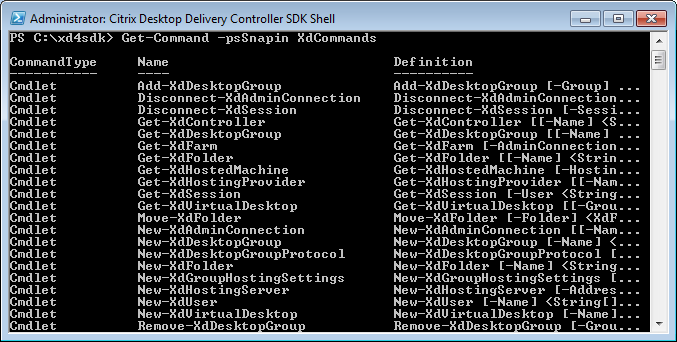
To get a list of the Get commands, showing just the Name, where the noun starts with “Xd”, type the following in the PowerShell session (results are shown in Figure 11):
Get-Command –Noun Xd* -Verb Get | Select-Object Name
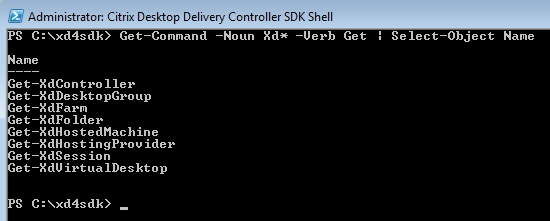
Of the eight Get-Xd* commands listed, only three are usable for documenting the Farm:
- Get-XdFarm
- Get-XdController
- Get-XdDesktopGroup
One feature I like about the XenDesktop PowerShell commands is that you are not required to run them directly on a Controller. You can use the –AdminAddress parameter to give the name or IP address of a Controller to run the command against. Since I am developing this script on a production Farm, I am being safe and staying off the customer’s production Controllers.
Typing each of the commands into the PowerShell session gave me the results shown in Figure 12, Figure 13, and Figure 14.
Note: I am using a Formatted List (| fl) to see all the properties returned by each command.
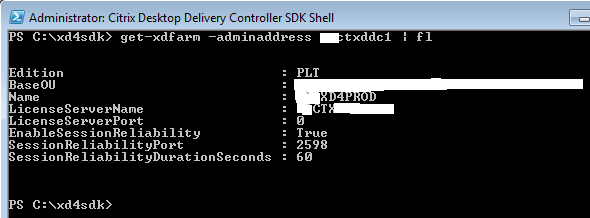
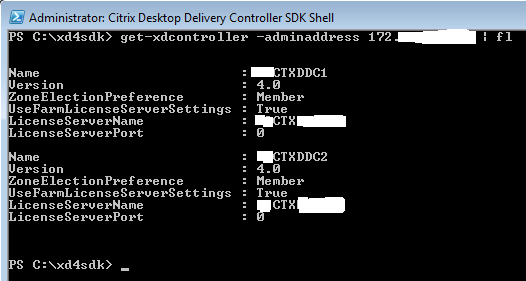
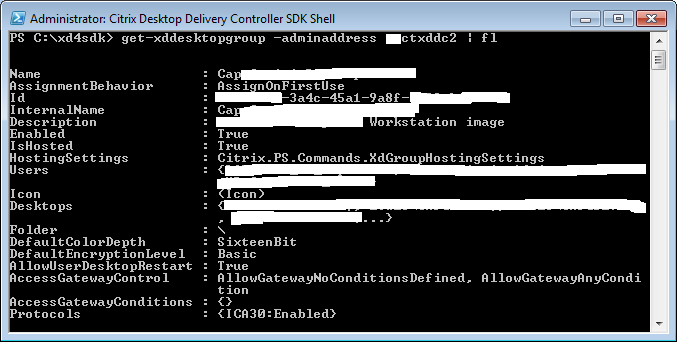
My goal is to use the same wording as what is seen in the DSC for headings, captions, and text. In order to do that, I needed a way to format the output text. Michael B. Smith (MBS) developed a function for me to use called Line.
1 2 3 4 5 6 7 8 9 10 11 12 13 14 15 16 17 18 19 | Function line#function created by Michael B. Smith, Exchange MVP#@essentialexchange on Twitter{ Param( [int]$tabs = 0, [string]$name = ’’, [string]$value = ’’, [string]$newline = “`n”, [switch]$nonewline ) While( $tabs –gt 0 ) { $global:output += “`t”; $tabs--; } If( $nonewline ) { $global:output += $name + $value } Else { $global:output += $name + $value + $newline }} |
Another lesson MBS taught me is to check to see if each cmdlet used returned an error and how to tell the cmdlet how I wanted to proceed if there was an error. This is done by using –ErrorAction, or –EA. ErrorAction has four values (Table 1):
Table 1
| Enumeration | Value | Description |
| SilentlyContinue | 0 | The Windows PowerShell runtime will continue processing without notifying the user that an action has occurred. |
| Stop | 1 | The Windows PowerShell runtime will stop processing when an action occurs. |
| Continue | 2 | The Windows PowerShell runtime will continue processing and notify the user that an action has occurred. |
| Inquire | 3 | The Windows PowerShell runtime will stop processing and ask the user how it should proceed. |
For this documentation script, I always use 0. If an error occurs, I want the rest of the script to continue.
Next, I needed to know how to test to see if an action, like Get-XdFarm, succeeded or had an error. MBS said to use $? to test if the most recent action succeeded (True) or had an error (False). For example:
1 2 3 4 5 6 7 8 9 | $farm = Get-XdFarm -EA 0If( $? ){ #success}Else{ #error} |
Because this script does not have to run on a Controller, a parameter is created to allow a Controller name or IP address to be used.
Let’s get started. We will build the script node by node. Some of the lines may wrap.
The beginning of the script:
1 2 3 4 5 6 7 8 9 10 11 12 13 14 15 16 17 18 19 20 21 22 23 24 25 26 27 28 29 30 31 32 33 | #Carl Webster, CTP and independent consultant#webster@carlwebster.com#@carlwebster on Twitter#This script written for "SR", March 9, 2012#Thanks to Michael B. Smith, Joe Shock, Jarian Gibson and James Rankin#for testing and fine-tuning tipsParam([string]$DDCAddress = "")Function line#function created by Michael B. Smith, Exchange MVP#@essentialexchange on Twitter{ Param( [int]$tabs = 0, [string]$name = ’’, [string]$value = ’’, [string]$newline = “`n”, [switch]$nonewline ) While( $tabs –gt 0 ) { $global:output += “`t”; $tabs--; } If( $nonewline ) { $global:output += $name + $value } Else { $global:output += $name + $value + $newline }}#script begins |
The first node in the DSC is the Farm itself.
1 2 3 4 5 6 7 8 9 10 11 12 13 14 15 16 17 18 19 20 21 22 23 24 25 26 27 28 29 30 31 32 33 34 35 36 37 38 39 40 41 42 43 44 45 46 47 | #get farm information$global:output = ""If($DDCAddress){ $farm = Get-XdFarm -adminaddress $DDCAddress -EA 0}Else{ $farm = Get-XdFarm -EA 0}If( $? ){ line 0 "XenDesktop Farm Name: " $farm.Name line 1 "XenDesktop Edition: " -nonewline switch ($farm.edition) { "PLT" {line 0 "Platinum" } "STD" {line 0 "VDI" } "ADV" {line 0 "Advanced" } "ENT" {line 0 "Enterprise"} default {line 0 "Farm Edition could not be determined: $($farm.edition)"} } line 1 "Base OU: " $farm.BaseOU line 1 "License server" line 2 "Name: " $farm.LicenseServerName line 2 "Port number: " $farm.LicenseServerPort line 1 "Session reliability" line 2 "Allow users to view sessions during broken connections: " $farm.EnableSessionReliability If($farm.EnableSessionReliability) { line 3 "Port number: " $farm.SessionReliabilityPort line 3 "Seconds to keep sessions active: " $farm.SessionReliabilityDurationSeconds }} Else { line 0 "XenDesktop Farm information could not be retrieved"}write-output $global:output$farm = $null$global:output = $null$global:output = "" |
Sample script output:
1 2 3 4 5 6 7 8 9 10 | XenDesktop Farm Name: SAMPLEXD4 XenDesktop Edition: Platinum Base OU: XD4BaseOU License server Name: CTXLICENSE Port number: 0 Session reliability Allow users to view sessions during broken connections: True Port number: 2598 Seconds to keep sessions active: 60 |
Even though the license server port number is displayed as 27000 in the console, the Citrix cmdlet returns 0.
The next node in the DSC is Administrators, but Citrix does not provide a way to retrieve any information about the Administrators.
The next node is the Controllers. Even though Controllers can be in folders, Citrix does not provide a way to retrieve Folder information.
1 2 3 4 5 6 7 8 9 10 11 12 13 14 15 16 17 18 19 20 21 22 23 24 25 26 27 28 29 30 31 32 33 34 35 36 37 38 39 | #get controller informationIf($DDCAddress){ $XDControllers = Get-XdController -adminaddress $DDCAddress -EA 0}Else{ $XDControllers = Get-XdController -EA 0}If( $? ){ line 0 "Desktop Delivery Controllers:" ForEach($XDController in $XDControllers) { line 1 "Controller: " $XDController.Name line 1 "Version: " $XDController.Version line 1 "Zone Election Preference: " $XDController.ZoneElectionPreference line 1 "License Server" If($XDController.UseFarmLicenseServerSettings) { line 2 "Using Farm Setting" } Else { Line 2 "License server" line 3 "Name: " $XDController.LicenseServerName line 3 "Port number: " $XDController.LicenseServerPort } line 1 "" }} Else { line 0 "Desktop Delivery Controller information could not be retrieved"}write-output $global:output$XDControllers = $null$global:output = $null |
Sample script output:
1 2 3 4 5 6 7 8 9 10 11 12 | Desktop Delivery Controllers: Controller: DDC1 Version: 4.0 Zone Election Preference: Member License Server Using Farm Setting Controller: DDC2 Version: 4.0 Zone Election Preference: Member License Server Using Farm Setting |
The last node is Desktop Groups. There are different options available depending on if the Desktop Group is Pooled or Assigned. Instead, I returned the AD Computer Account name as shown in the console, and the cmdlet returns the Machine SID. Also, not every user account returned a name, but the User SID was always returned. MBS showed me how to convert a Machine or User Account SID to the Machine or User Name.
1 2 3 | $objSID = New-Object System.Security.Principal.SecurityIdentifier ($Desktop.MachineSid.Value)$objComputer = $objSID.Translate([System.Security.Principal.NTAccount])"AD Computer Account: " $objComputer.Value |
And
1 2 3 | $objSID = New-Object System.Security.Principal.SecurityIdentifier($Desktop.AssignedUserSid.Value)$objUser = $objSID.Translate([System.Security.Principal.NTAccount])“Assigned User: “ $objUser.Value |
1 2 3 4 5 6 7 8 9 10 11 12 13 14 15 16 17 18 19 20 21 22 23 24 25 26 27 28 29 30 31 32 33 34 35 36 37 38 39 40 41 42 43 44 45 46 47 48 49 50 51 52 53 54 55 56 57 58 59 60 61 62 63 64 65 66 67 68 69 70 71 72 73 74 75 76 77 78 79 80 81 82 83 84 85 86 87 88 89 90 91 92 93 94 95 96 97 98 99 100 101 102 103 104 105 106 107 108 109 110 111 112 113 114 115 116 117 118 119 120 121 122 123 124 125 126 127 128 129 130 131 132 133 134 135 136 137 138 139 140 141 142 143 144 145 146 147 148 149 150 151 152 153 154 155 156 157 158 159 160 161 162 163 164 165 166 167 168 169 170 171 172 173 174 175 176 177 178 179 180 181 182 183 184 185 186 | #get desktop group information$global:output = ""If($DDCAddress){ $XDGroups = Get-XdDesktopGroup -adminaddress $DDCAddress -EA 0}Else{ $XDGroups = Get-XdDesktopGroup -EA 0}If( $? ){ line 0 "Desktop Groups:" ForEach($XDGroup in $XDGroups) { line 1 "Basic" line 2 "Desktop Group Name" line 3 "Display name: " $XDGroup.Name line 3 "Description: " $XDGroup.Description line 3 "Desktop Group name: " $XDGroup.InternalName line 3 "Disable desktop group: " -nonewline If($XDGroup.Enabled) { line 0 "group is enabled" } Else { line 0 "group is disabled" } line 2 "Assignment Type" line 3 "Assignment Behavior: " $XDGroup.AssignmentBehavior If($XDGroup.IsHosted) { line 2 "Hosting infrastructure: " $XDGroup.HostingSettings.HostingServer } line 2 "Users" line 3 "Configured users:" ForEach($User in $XDGroup.Users) { line 4 $User #line 4 "SID: " $User.Sid line 4 "Group or User: " -nonewline If($User.IsSecurityGroup) { line 0 "Group" } Else { line 0 "User" } } line 2 "Virtual Desktops" line 3 "Virtual desktops:" ForEach($Desktop in $XDGroup.Desktops) { line 4 "Folder: " $XDGroup.Folder line 4 "Virtual Machine: " $Desktop $objSID = New-Object System.Security.Principal.SecurityIdentifier ($Desktop.MachineSid.Value) $objComputer = $objSID.Translate([System.Security.Principal.NTAccount]) line 4 "AD Computer Account: " $objComputer.Value line 4 "Desktop State: " $Desktop.State line 4 "Assigned User: " -nonewline If($Desktop.AssignUserName) { line 0 $Desktop.AssignUserName } ElseIf($Desktop.AssignedUserSid) { $objSID = New-Object System.Security.Principal.SecurityIdentifier ($Desktop.AssignedUserSid.Value) $objUser = $objSID.Translate([System.Security.Principal.NTAccount]) line 0 $objUser.Value } Else { line 0 "" } line 4 "Maintenance Mode: " $Desktop.MaintenanceMode line 4 "Machine State: " $Desktop.PowerState line 4 "Controller: " $Desktop.Controller line 4 "Agent Version: " $Desktop.AgentVersion line 1 "" } line 1 "Advanced" line 2 "Access Control" $test = $XDGroup.AccessGatewayControl.ToString() $test1 = $test.replace(", ","`n`t`t") line 3 $test1 line 2 "Access Gateway Conditions: " ForEach($Condition in $XDGroup.AccessGatewayConditions) { line 3 $Condition } line 2 "Client Options" line 3 "Appearance" line 4 "Colors: " -nonewline switch ($XDGroup.DefaultColorDepth) { "FourBit" {line 0 "16 colors" } "EightBit" {line 0 "256 colors" } "SixteenBit" {line 0 "High color (16-bit)"} "TwentyFourBit" {line 0 "True color (24-bit)"} default {line 0 "Color depth could not be determined: $($XDGroup.DefaultColorDepth)"} } line 3 "Connection" line 4 "Encryption: " -nonewline switch ($XDGroup.DefaultEncryptionLevel) { "Basic" {line 0 "Basic" } "LogOnRC5Using128Bit" {line 0 "128-Bit Login Only (RC-5)"} "RC5Using40Bit" {line 0 "40-Bit (RC-5)" } "RC5Using56Bit" {line 0 "56-Bit (RC-5)" } "RC5Using128Bit" {line 0 "128-Bit (RC-5)" } default {line 0 "Encryption level could not be determined: $($XDGroup.DefaultEncryptionLevel)"} } line 3 "Connection Protocols: " ForEach($Protocol in $XDGroup.Protocols) { line 4 "Name: " $Protocol.Protocol line 4 "Enabled: " $Protocol.Enabled } #only show the next section if the Desktop Group is Pooled If($XDGroup.AssignmentBehavior -eq "Pooled") { line 2 "Idle Pool Settings" line 3 "Business Hours" line 4 "Business days " ForEach($Day in $XDGroup.HostingSettings.BusinessDays) { line 5 $Day } line 4 "Time zone " $XDGroup.HostingSettings.IdleTimesTimeZone IF($XDGroup.HostingSettings.PeakHoursStart) { line 4 "Day start " $XDGroup.HostingSettings.PeakHoursStart.ToString() } If($XDGroup.HostingSettings.PeakHoursEnd) { line 4 "Peak end " $XDGroup.HostingSettings.PeakHoursEnd.ToString() } If($XDGroup.HostingSettings.BusinessHoursEnd) { line 4 "Day end " $XDGroup.HostingSettings.BusinessHoursEnd.ToString() } line 3 "Idle Desktop Count" line 2 "Business hours " $XDGroup.HostingSettings.BusinessHoursIdleCount line 2 "Peak time " $XDGroup.HostingSettings.PeakHoursIdleCount line 2 "Out of hours " $XDGroup.HostingSettings.OutOfHoursIdleCount } # I can't find these settings in the console line 1 "Other settings" line 2 "Allow User Desktop Restart: " $XDGroup.AllowUserDesktopRestart line 2 "Tainted Machine Action: " $XDGroup.HostingSettings.TaintedMachineAction line 3 "Actions: " ForEach($Action in $XDGroup.HostingSettings.Actions) { line 4 "Action point: " $Action.ActionPoint line 4 "Action: " $Action.Action line 4 "Delay: " $Action.Delay line 4 "" } line 1 "" }} Else { line 0 "Desktop Group information could not be retrieved"}write-output $global:output$XDGroups = $null$test = $null$test1 = $null$global:output = $null |
Sample script output:
1 2 3 4 5 6 7 8 9 10 11 12 13 14 15 16 17 18 19 20 21 22 23 24 25 26 27 28 29 30 31 32 33 34 35 36 37 38 39 40 41 42 43 44 45 46 47 48 49 50 51 52 53 54 55 56 57 58 59 60 61 62 63 64 65 66 67 68 69 70 71 72 73 74 75 76 77 78 79 80 81 | Desktop Groups:Basic Desktop Group Name Display name: WebstersLab Description: Used in Webster’s Lab for writing purposes Desktop Group name: WebstersLab Disable desktop group: group is enabled Assignment Type Assignment Behavior: Pooled Hosting infrastructure: http://msvirtualcenter.carls.com/sdk Users Configured users: CARLS\TS_XD_Lab Group or User: Group CARLS\TS_XD_Lab_Admin Group or User: Group Virtual Desktops Virtual desktops: Folder: \ Virtual Machine: CARLS\COMPUTER01$ AD Computer Account: CARLS\COMPUTER01$ Desktop State: Available Assigned User: Maintenance Mode: False Machine State: On Controller: DDC1 Agent Version: 4.0.4522 Folder: \ Virtual Machine: CARLS\COMPUTER06$ AD Computer Account: CARLS\COMPUTER06$ Desktop State: NotRegistered Assigned User: Maintenance Mode: False Machine State: On Controller: Agent Version: Advanced Access Control AllowGatewayNoConditionsDefined AllowGatewayAnyCondition Access Gateway Conditions: Client Options Appearance Colors: High color (16-bit) Connection Encryption: Basic Connection Protocols: Name: ICA30 Enabled: True Idle Pool Settings Business Hours Business days Sunday Monday Tuesday Wednesday Thursday Friday Saturday Time zone (UTC-05:00) Eastern Time (US & Canada) Day start 01:00:00 Peak end 20:30:00 Day end 23:30:00 Idle Desktop Count Business hours 7 Peak time 7 Out of hours 7 Other settings Allow User Desktop Restart: False Tainted Machine Action: Restart Actions: Action point: Disconnect Action: DoNothing Delay: 300 Action point: LogOff Action: Shutdown Delay: 420 |
How to use this script?
I saved the script as XD4_Inventory.ps1 in the Z:\ folder. From the PowerShell prompt, change to the Z:\ folder or the folder where you saved the script. From the PowerShell prompt, type in:
.\XD4_Inventory.ps1 |out-file Z:\XD4Farm.txt and press Enter, or
.\XD4_Inventory.ps1 DDCName|out-file Z:\XD4Farm.txt and press Enter, or
.\XD4_Inventory.ps1 DDCIPAddress|out-file Z:\XD4Farm.txt and press Enter.
Open XD4Farm.txt in either WordPad or Microsoft Word (Figure 15).
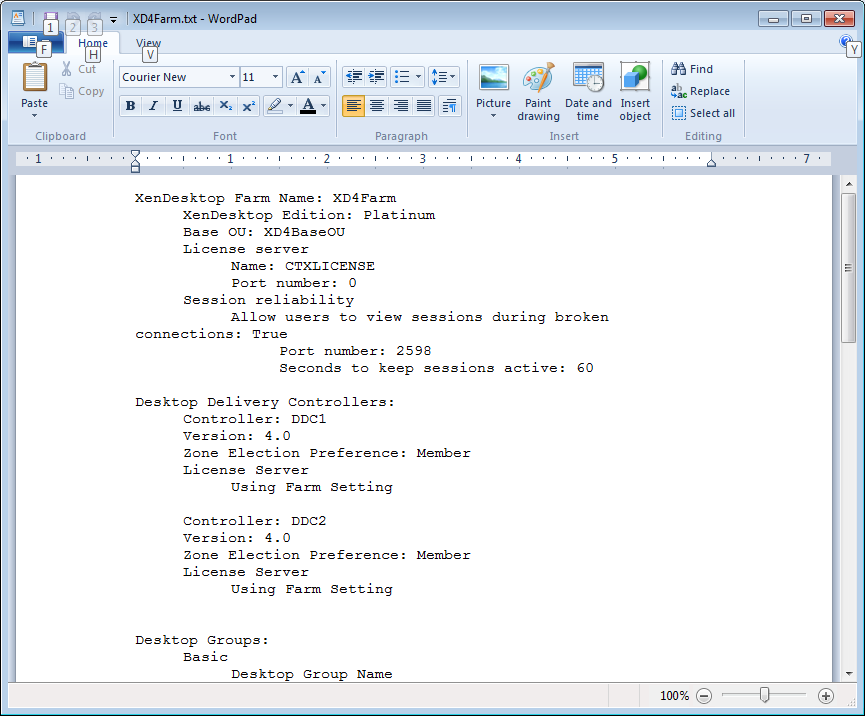
You can always find the most current script by going to https://www.carlwebster.com/where-to-get-copies-of-the-documentation-scripts/
Thanks
Webster

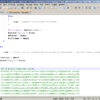
Hi Carl,
Thanks for your articles, always brilliant and detailled ! They really help us, we, poor quarks lost in the Citrix Known Universe 😉
Do you know when an XD56 version of the documentation scripts will be released ?
May the force be with you
Cheers
e-Van
as soon as I can get access to a XD5.6 environment I can write the script. None of my customers use XD and I am too busy with paid work to have the time to build up a XD lab.
Thanks
Webster